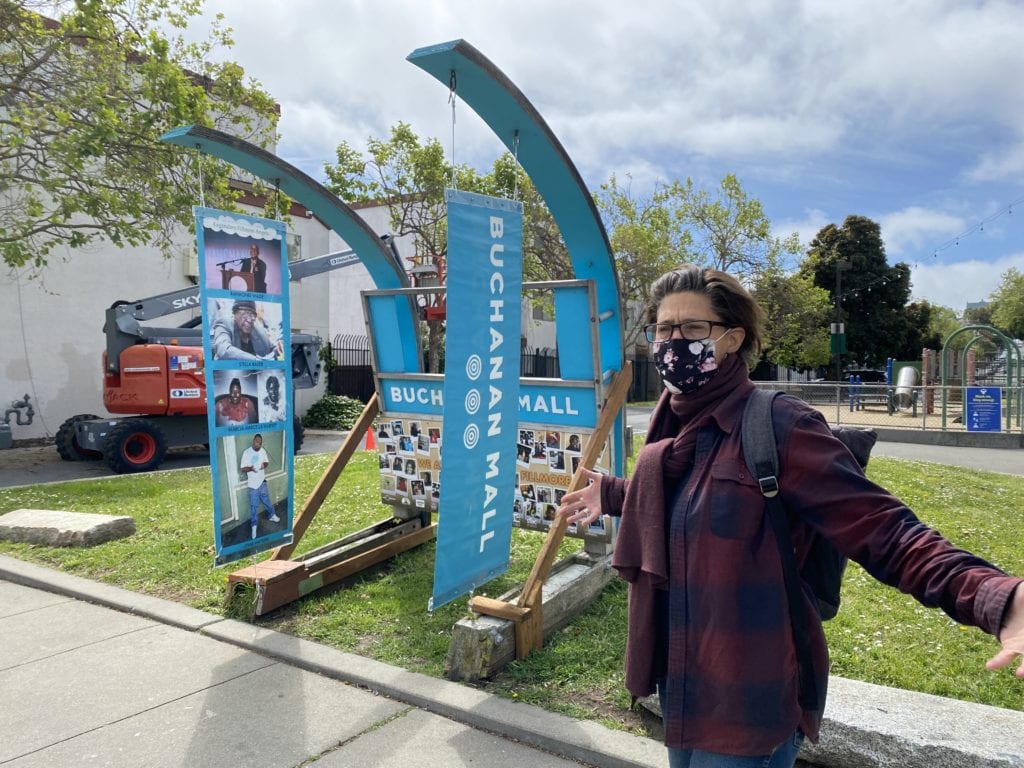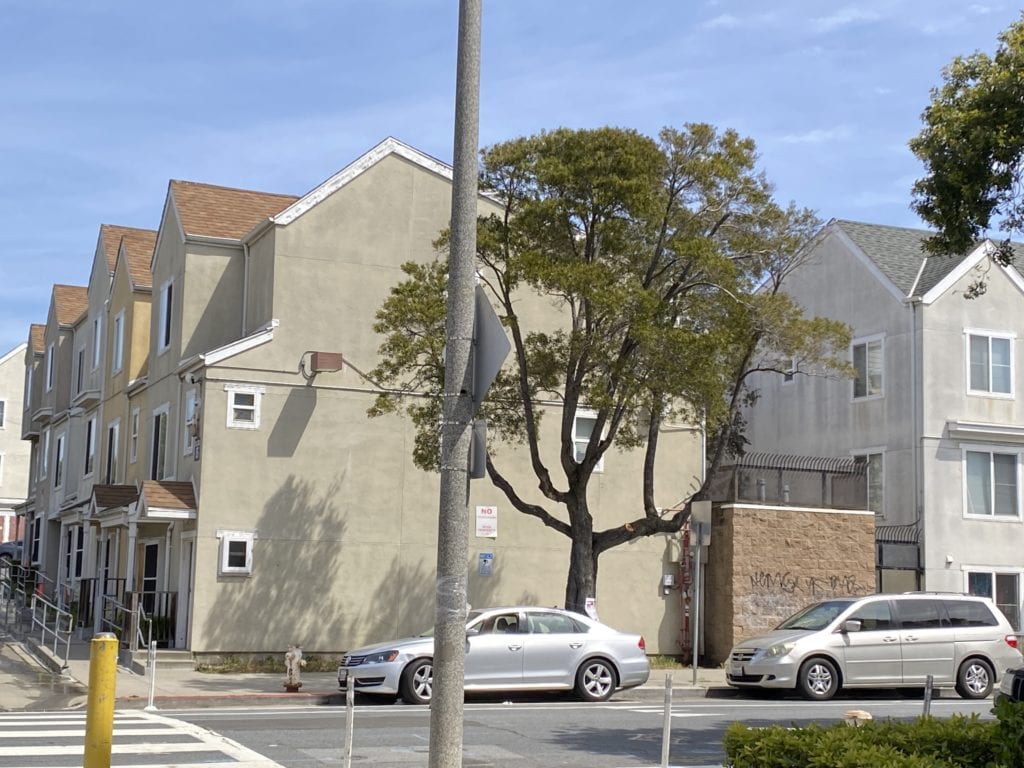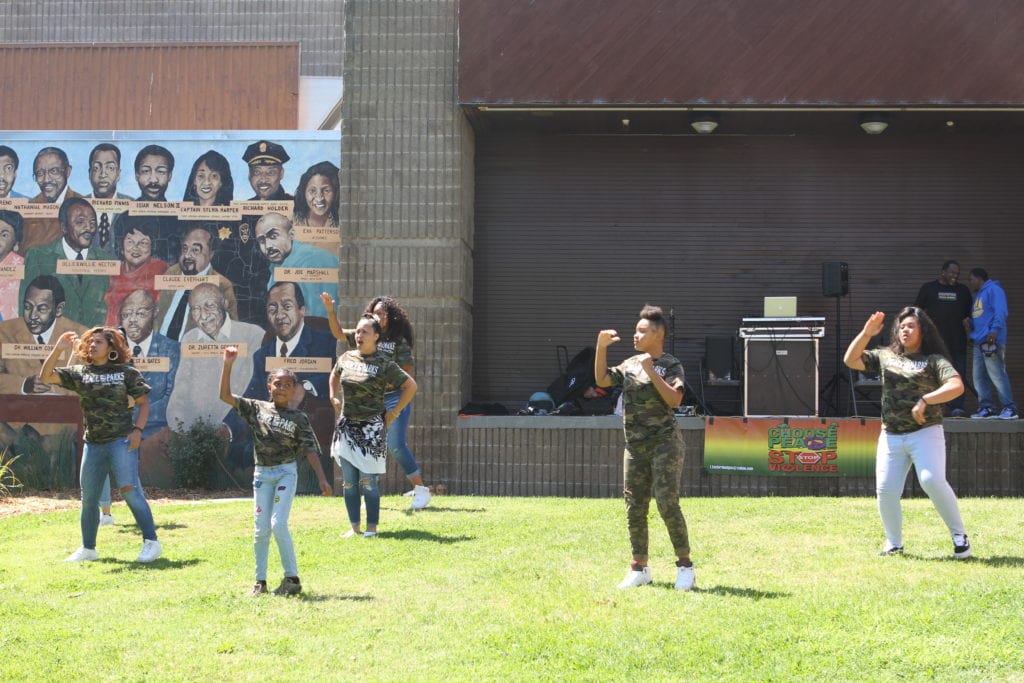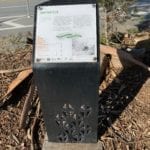
(Photos by Bonnee Waldstein except where noted.)
“At 23, I was like, how do you get into the film business and make a living? So I asked a documentary filmmaker friend. She said, if you don’t have a trust fund, go get another job and you can make films if you want to.”
Sophie Constantinou, now 53, and resident of Bernal Glen for the last eighteen years, has found a way to make it work without a trust fund, and has done even more. In the past few years, after making a documentary film about the Buchanan Mall project in the Western Addition, she became passionate about helping the community bring it to fruition and nurturing it as it continues to evolve.
In turn, this led her to apply citizen power closer to home, when she teamed up with neighbors to bring the nearby Bernal Cut green space adjoining San Jose Avenue into a state of peace and beauty.
Born and raised in the town of Stanford, California, Constantinou became a cinematographer after she graduated from the film program at UC Berkeley. She is one of the founders of Citizen Film, a nonprofit documentary film company that formed in 2002 with an office on Fillmore Street. In addition to her work behind the camera, Constantinou also directs and produces and is partners with Sam Ball, the lead producer/director, and Kate Stilley Steiner, who heads the editorial arm. Together their skills and ethic are a perfect match.
Getting their films made requires an entrepreneurial spirit. They work with other nonprofits and Constantinou notes, “By hook or by crook, we have to raise the money to do it, or we’re hired by another nonprofit who has to figure out how to raise the money.”

Citizen Film has just been awarded its third one-year Community Challenge Grant (CCG), this one for $120,000, relating to the Buchanan Mall. (These CCG funds came from business tax dollars earmarked for the arts.) It’s a five-block stretch of Buchanan Street, bounded by Fulton to Eddy streets to the north and south; and Laguna and Webster Streets to the east and west.
The history of the Western Addition is complex and emblematic of the systemic racism that permeated (but did not begin with) the political and social policies of the post-World War II era.


In San Francisco, the shorthand term for what happened to this neighborhood is Redevelopment, euphemistically named for the city agency that held the key to the future of the Western Addition. After the 1906 earthquake, which didn’t damage this part of the city, there was an influx of Black people, Japanese and Jews, including to the neighboring Fillmore district, and the area became a cultural center with a vibrant jazz scene.

During World War II, the local Japanese people, whose presence was very strong, were taken to internment camps and left the neighborhood scarred. After the war, shipbuilding, other industries, and Jim Crow laws, attracted large numbers of Black people from the south. Public housing towers were built for the growing population in the 1950s. The practice of redlining consigned the Black population to this neighborhood and to the Bayview. In the 1960s the area was declared blighted by the city. The towers proved to cause many social problems, and they were torn down in 2000.

Thousands of houses, including low rent housing units, were seized by eminent domain and either demolished or, in the case of the beautiful Victorians, moved to Pacific Heights. Local businesses were bought out, further destroying the fabric of the community. The local population was promised new, smaller scale, livable housing, and given vouchers, but for years the land sat fallow, while the people scattered, many never to return. Finally, in the late 1960s and 1970s, seven affordable apartment complexes were built on the site, but each was socially disconnected from one another.

The Buchanan Mall space was meant to be a community gathering hub for all the housing complexes, and for several years it was, albeit with few amenities. But implementation of the plans for garden beds, murals and installations for the area’s 30,00 residents got buried in the wake of all the social upheaval of the period, and the city’s bureaucratic inertia.
Instead of a welcoming public park right in their backyard, throughout the 1990s and 2000s gun violence, the crack wars and turf battles rendered the mall a place to be feared, avoided, or traversed as quickly as possible. Even though the threat has decreased recently, people remain wary.
Community engagement and citizen power is what has breathed life into the mall. It’s a challenge to engage people who aren’t homeowners to make a commitment to their neighborhood. The process is neatly summarized in this brief video.
Citizen Film has documented the evolution of the mall in several short documentaries. Here’s an example of the collaborative process. In scenes that will ring a bell with those who’ve attended community meetings about a project proposal and groused and grumbled, we see neighbors, guided by a neighbor-led design task force, sketching out their ideas, sharing them, prioritizing them, and achieving compromise and acceptance.



Work started in 2014-15. Banners touting the Buchanan Mall were hung. Garden beds, murals and installations were achieved with the help of the first and second CCGs. The current grant is for another installation called The Opportunity Hub, a micro-enterprise kiosk that might be open all the time or just for events at the mall. (See rendering below.) There’s a neighborhood entrepreneurship task force that will be managing it with local businesses, because economic opportunity is one of the biggest challenges here and for the community.


In 2016, the Buchanan Mall was launched on its way toward achieving community solidarity. Many events took place on a regular basis, such as First Fridays, Holiday Fair and Kwanzaa, among others. And there were all manner of performances, food and games happening.

Photo courtesy of Sophie Constantinou

Photo: Widya Batin

Photo: courtesy of Sophie Constantinou
A key element in making the mall relevant to all was the Youth Leadership Team and the Sound Dome. From their elders, the youth learned local history that they previously had no idea about. Through this interaction, the elders wanted to help the young people on their path to change. Thus, intergenerational connections and ways of communicating were strengthened. These conversations were recorded and filmed by the youth with the mentorship of Citizen Film and can be viewed at the Sound Dome installation.
Teaching her craft to young people has been one of the most rewarding things for Constantinou as a filmmaker. “What does it mean to lift up the voices and the stories of the people who have done positive things rather than always focusing on poverty or loss or violence? There are as many, if not more, beautiful stories than there are stories of struggle and hardship. A big piece of this is, how do you bring those stories to the top?”
Another installation celebrates the lives of the neighborhood activists who have passed away, and yet another memorializes those lost to gun violence.

The murals adorning the adjacent Ella Hill Hutch community center, which runs after-school programs, and the Rosa Parks Senior Center, focus on the heyday of the Fillmore and Western Addition, when it was the hub of a jazz scene, the “Harlem of the West,” and thriving Black businesses and community leaders, as well as the troubles that followed.

Artist Eugene White painted a mural on the Ella Hill Hutch Community Center and ran the Mo’ Magic after-school and summer programs. He died in 2019. Andre Jones, executive director of the Bay Area Mural Program, and other artists, have done several elements of the Rosa Parks Senior Center mural.
The initial modeling of the Buchanan Mall was meant to last for only one year, as an “activation spark,” while permanent elements would be imagined and built. With the passage of Prop. A last November, the mall is scheduled to get seed funding plus additional funds for permanent installations. The block from Golden Gate Avenue to McAllister will undergo a one-year renovation in 2022.
A project of this scope requires the funds and sweat equity of many organized groups. The core partners are Green Streets, Exploratorium, San Francisco Recreation and Parks, The Trust for Public Land, and Citizen Film. Other organizations contributed in many ways.
The funders and supporters are shown here .
Constantinou, ever involved in the people and physical space of the Buchanan Mall, always connects back to film. “The filmmaking is our area of expertise. And this project is unlike anything I have done before. It is iterative storytelling: evolving as we go, listening and reflecting. It’s clear that investment in public spaces is a long, long process, that these little community grants can leverage much larger city, state and federal dollars. So, part of telling and retelling the community stories is amplifying a narrative that has been suppressed, like the devastating generational impact of redevelopment or mass incarceration. But it is also about documenting and reflecting a continuity of opinion that holds the city accountable for equitable investment in neighborhoods. I believe that telling the beautiful stories, documenting, and illuminating the neighborhood character, is my way of showing respect to them and asking others to consider doing the same.”
Since the pandemic, Citizen Film has closed its Fillmore Street office and now works out of the Rosa Parks Senior Center. Things are much quieter in the space since the public events that had become popular are not possible at this time. The community engagement that Constantinou thrives upon has been curtailed, but she persists.
Working from this location means Constantinou can keep both eyes trained on the Buchanan Mall.
You never know when a banner will become unmoored.

But wait, there’s more.
Constantinou lives on Richland Avenue in Bernal Glen, and she started making some mental connections.
The Bernal Cut moniker encompasses a half-mile of hillside and pedestrian pathway along the east side of San Jose Avenue and the J-Church route. The most improved area is from St. Mary’s Avenue to Highland Avenue. Constantinou lives near the pathway.
There’s a mural at the Randall/Mission end of the path, and volunteers do monthly graffiti abatement and mulching between Randall and Highland.
“One of my big lessons in doing the work in Buchanan was that there’s a need for community engagement in our public spaces. I suddenly started making connections between city government and departments and how they work, and I realized that there are big equity issues around the Buchanan Mall…The Western Addition is not ‘mine.’ In many ways the Bernal Cut is mine, I love it, I nurture it, I plant it.”
From a longtime neighbor, Constantinou learned about the nearby hillside plants and trees. Citizen Film teamed up with the College Hill Neighborhood Association to form the Bernal Cut Restoration Project. Constantinou started planting things from donated plants and trees and began to write grants. The community got involved. There were specific problems, like the lack of lighting, so they wrote a grant for lights. Traffic on Richland is terrible and there’s no signal on Highland, so they got a crosswalk and signs.
Going forward, Constantinou is eager to keep partnering with Glen Park neighbors across the Cut who work the Arlington Path and to continue the beautification and stewardship of unused public land. She’s also excited about expanding the native flora and supporting biodiversity in the city.
“My favorite natives are now bursting forth: Clarkia, Sticky Monkey, irises, and even the sages are flowering despite the drought.
“Even here in the Glen Park/Bernal Glen neighborhood we must bridge the changes of leadership in city government,” she continues, “like SFPW or even a supervisor, to address the issues that are important for our well-being and safety. It’s everything from getting a crosswalk or a public trash collection to addressing unhoused mentally ill folks living under the bridges.”
Constantinou’s vision illustrates that our problems are citywide, as are the solutions.
Community engagement, perseverance, and a driving sense of what connects us all, regardless of background, is the key.
Along the Bernal Cut:
(Click on thumbnails to display image; click again to enlarge image.)
All about Citizen Film:
https://en.wikipedia.org/wiki/Citizen_Film
https://www.facebook.com/CitizenFilm.org/
For a comprehensive visual history of the Fillmore/Western Addition, the legacy of Redevelopment and its local heroes, watch this: https://www.youtube.com/watch?v=SDndNpVx3uY
Citizen Films about the Buchanan Mall:
Buchanan Mall vision and plan pdf:
http://www.buchananstories.org/wp-content/uploads/2017/06/170324_BuchVision-FINAL.pdf
Buchanan Mall on social media: To find out what’s going on now (or pre-Covid):
Facebook – https://www.facebook.com/BuchananMallNew
IG: https://www.instagram.com/buchananmallsf/
Twitter: https://twitter.com/buchananmallSF
https://sfrecpark.org/1134/Buchanan-Street-Mall-Project
Read about Bernal Cut history:
https://www.foundsf.org/index.php?title=Bernal_Cut
Catch up on Bernal Cut today:
Dream Bernal Cut pipe dreams:








